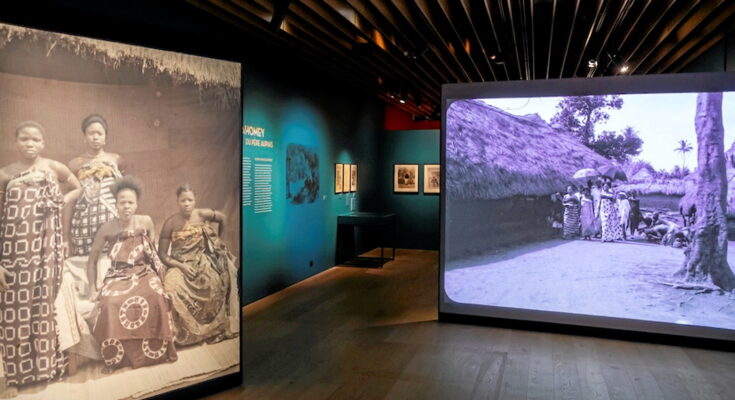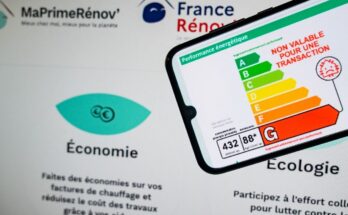Youdon’t crunch. In this huge documentary enterprise of the Archives of the Planet, launched by the philanthropist banker Albert Kahn between 1909 and 1931, with the ambition to “retouch the diversity of human civilization on film”, only one mission was carried out in Africa, in Dahomey (now Benin). However, among the hundreds of missions carried out from Japan to Syria via Lebanon, the Dahomey mission, led by Francis Aupiais, missionary chaplain of the Society of African Missions of Lyon, and Frédéric Gadmer, cinema operator and photographer, remains unique in its duration and scale in terms of the archives produced.
For four and a half months, from January to May 1930, the two men crisscrossed the kingdom, from Porto-Novo to Abomey via Cotonou and Ouidah. They brought back more than 1,000 autochromes (the first color photographs on glass plates) and 140 rolls of film, or nearly eight and a half hours of pictures. This is the story told in the exhibition “Benin, return home – Regards sur le Dahomey (1930)” at the Albert-Kahn departmental museum in Boulogne-Billancourt.Pastor Aupiers, an extraordinary missionary
Father Francis Aupiais (1877-1945) convinced Albert Kahn to lead this project. For more than 20 years, at the beginning of the 20th centurye century, he lived in Dahomey. “Father Aupiers was not a missionary like the others,” explains Julien Faure-Conorton, one of the exhibition’s curators. “He understood early on that local religious practices concealed a spirituality as deep as the Christian faith. Voodoo was not pagan worship, but a growing religion.” In 1925, he founded the magazine African Confessionwritten by Dahomean people to promote African culture. This mission in Dahomey had two goals: to document evangelization, “an ecclesiastical order, but also to introduce the glories of a little-known civilization,” explains David-Sean Thomas, one of the curators. A film that illustrates the benefits of a Catholic presence, Christian Dahomeymore than two and a half hours were produced.
On the other hand, 14 films more in line with Albert Kahn’s calling are devoted to dance, royal ceremonies, funeral rites, and voodoo practices. All of these films have been digitized in high definition, which allows us to extract still images of exceptional quality. This ensemble today represents a unique visual heritage in colonial Dahomey.
Shot
Frédéric Gadmer’s image respects the specifications laid down by Jean Brunhes, scientific director of the Archives of the Planet. The aim was to document various aspects of life in Dahomey: agriculture, crafts, architecture, as well as voodoo ceremonies and the royal family. In the field, equipped with a photographic camera, he produced autochromes and film with two cameras, one small portable camera, the Ica, and another much larger exposed one.
“The films explain the overall economic interest in the exploitation of palm oil, which was Dahomey’s main wealth at the time, to make soap and oil for lighting, alongside other resources, such as cotton and wood, which were in great demand by the French,” said David-Sean Thomas. Digital restoration of the reels allows frame freezes revealing domination movements and forced labor scenes.
When Benine artists reverse the focus
The exhibition presents a dialogue between images of the past and the work of contemporary artists, most of whom are from Benine. These paintings, photographs, installations and performances are a reappropriation of confiscated history. From the entrance, a large painting on sheet by Roméo Mivekannin representing Prince Robert Danba Béhanzin and his wife immerses visitors in Dahomey. In another painting, he was inspired by Gadmer’s autochrome representation of Mother Mélanie, a French nun posing next to King Béhanzin’s throne, and took a self-portrait at the nun’s feet. The symbolic violence in evangelization is obvious.
Another artist, Ishola Akpo also recalls memories of Dahomey through portraits of women, namely the Amazon queen Tassi Hangbé, long removed from her royal lineage or her mother, a Catholic but also a descendant of a voodoo official. “Her work aligns with our exhibition and also shows the full complexity of this region,” commented Julien Faure-Conorton.
At the end of the exhibition, the exhibition also presents two performances by South African artists. Bronwy Lace, William Kentridge co-founder of the Center for the Less Good Idea, presents Amazing Grape. Dancer and choreographer Thulani Chauke was involved in the Zodéougan regional chief’s performance. These artists did not reject the colonial archive, they appropriated it and reinterpreted it. Therefore, the works of artists Angelo Moustapha, Sénami Donoumassou or Marcus Neustetter are interwoven with photographs and films from the Archives of the Planet. Many of the objects loaned by the Quai Branly museum also respond to images in 3D to complete this journey through time.
To find
Kangaroo today
Answer
Through its title, “Benin, Round Trip Views of Dahomey in 1930”, this exhibition encapsulates his entire philosophy: how a French missionary and filmmaker viewed Dahomey in 1930 and a century later, how Benine artists force us to see it.
* Albert-Kahn Departmental Museum from 14 October 2025 to 14 June 2026. “Benin, round trip – Salam sur le Dahomey (1930)”, Boulogne-Billancourt.



